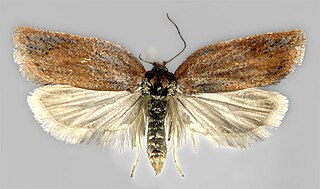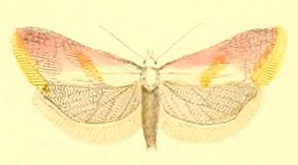
Archips xylosteana, the variegated golden tortrix or brown oak tortrix, is a moth of the family Tortricidae.

Aleimma loeflingiana is a moth of the family Tortricidae. It is found in Europe and the Near East.

Celypha cespitana is a moth of the family Tortricidae. It is found in the Palearctic realm, from western Europe to the Ural Mountains, Transcaucasia, Asia Minor, the Near East, Iran, Russia, north-eastern China (Manchuria), Korea and Japan. It is also found in the Nearctic realm.

Acleris rhombana, the rhomboid tortrix, is a moth of the family Tortricidae. It is found in the Palearctic realm, from Europe to the Caucasus, Armenia, and Turkmenistan.

Acleris rufana is a moth of the family Tortricidae. It is found from northern, central and south-western Europe through southern Siberia to the Russian Far East and Japan.

Apotomis capreana is a moth of the family Tortricidae. It is found in most of Europe, east to the eastern part of the Palearctic realm.

Cochylis hybridella is a moth species of the family Tortricidae. It is found in most of Europe, the Near East, China, Japan, Korea and Russia.

Apotomis betuletana is a moth of the family Tortricidae. It is found in most of Europe. It is also found in the eastern part of the Palearctic realm. The habitat consists of woods and woodland margins where birch occurs.

Cochylichroa atricapitana, the black-headed conch, is a moth of the family Tortricidae. It is found in China (Xinjiang) and the eastern Palearctic and most of Europe.

Cochylis dubitana, the little conch, is a moth of the family Tortricidae. It is found in China (Heilongjiang) and most of Europe. and the Caucasus. It is also found in North America, where it has been recorded from Colorado, Maine, Ontario and Washington.

Aethes francillana, the long-barred yellow conch, is a moth of the family Tortricidae. It was described by Johan Christian Fabricius in 1794. It is found in almost all of Europe, from north-western Africa to Afghanistan and Dzungarian Alatau in Central Asia. It is also found in the Ural Mountains, Kazakhstan, Tajikistan, western Siberia, Asia Minor and Iran. The habitat consists of rough grassland, particularly chalk downland and coastal areas.

Ancylis myrtillana is a moth of the family Tortricidae. It was described by Treitschke in 1830. It is found in most of Europe and across the Palearctic.It has also been recorded in North America. The habitat consists of moorland.

Acleris schalleriana, the viburnum button or Schaller's acleris moth, is a moth of the family Tortricidae. It was described by Carl Linnaeus in 1761. It is found in most of Europe. It is also found in North America. Acleris viburnana is a possible synonym that refers to the North American populations.

Gynnidomorpha vectisana, the small saltern conch, is a moth of the family Tortricidae. It was described by Henry Noel Humphreys and John O. Westwood in 1845. It is found in China, Japan, Korea, Ireland, Great Britain, Scandinavia, the Benelux, Germany, the Czech Republic, Slovakia, Hungary, Romania, Switzerland, Austria, Italy, Spain, the Baltic region and Russia. The habitat consists of saltmarshes, fens, wet heathland and freshwater marshes.

Cochylis flaviciliana, the gold-fringed conch, is a moth of the family Tortricidae. It was described by Westwood in 1854. It is found in most of Europe and north-western Africa. The habitat consists of chalky grasslands.

Cochylis pallidana, the sheep's-bit conch, is a moth of the family Tortricidae. It was described by Zeller in 1847.

Cnephasia longana, the omnivorous leaftier moth, long-winged shade or strawberry fruitworm, is a moth of the family Tortricidae. It was described by Adrian Hardy Haworth in 1811. It is native to western Europe. It is an introduced species in western North America. The species has also been reported from north-western Africa and Asia. The habitat consists of downland and rough ground.

Phalonidia affinitana, the large saltmarsh conch or large saltmarsh bell, is a species of moth of the family Tortricidae, the subfamily Tortricinae, and the tribe Cochylini. It is found in China, Japan, Korea, Russia and most of Europe. Its habitat consists of salt marshes.

Acleris permutana is a species of moth of the family Tortricidae. It is found in Ireland, Great Britain, Portugal, Spain, France, Belgium, the Netherlands, Germany, Denmark, Sweden, Austria, Italy, the Czech Republic, Slovakia, Slovenia, Croatia, Hungary, Romania, North Macedonia and Russia. The habitat consists of coastal sandhills and limestone.

Ancylis unguicella is a moth belonging to the family Tortricidae. The species was first described by Carl Linnaeus in his landmark 1758 10th edition of Systema Naturae.




















